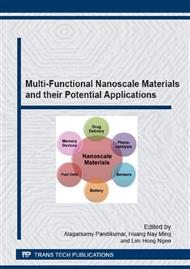[1]
C. Reichardt, Solvatochromic Dyes as Solvent Polarity Indicators, Chem. Rev. 94, (1994), 2319.
DOI: 10.1021/cr00032a005
Google Scholar
[2]
V. Sasirekha, V. Ramakrishnan, Study of preferential solvation of 2, 6-diaminoanthra-quinone in binary mixtures by absorption and fluorescence studies, Spectrochim Acta., 70, (2007), 626.
DOI: 10.1016/j.saa.2007.08.013
Google Scholar
[3]
S. R. Flom, P. F. Barbara, Proton transfer and hydrogen bonding in the internal conversion of S1 anthraquinones, J. Phys. Chem. 89, (1985), 4489.
DOI: 10.1021/j100267a017
Google Scholar
[4]
Kawski, Z. Naturforsch, On the Estimation of Excited-State Dipole Moments from Solvatochromic Shifts of Absorption and Fluorescence, SpectraActa Phys. Polon,. 57a, (2002), 255.
DOI: 10.1515/zna-2002-0509
Google Scholar
[5]
V. A. Gunyakov, A. M. Parshin and V. F. Shabanov, Temperature dependence of the effective anchoring energy for a nematic-ferroelectric interface, Eur. phys. J. E 20, (2006), 467.
DOI: 10.1140/epje/i2006-10037-9
Google Scholar
[6]
W. D. R. Joseph, N. R. Pradhan, Suneel Singh and D. Narayan Rao, Electroabsorption spectroscopy: A versatile tool to measure optical nonlinearities Current Science, 86, (2004), 1283.
Google Scholar
[7]
Kawski, B. Kuklinski, P. Bojarski and Z. Naturforsch. Thermochromic Absorption, Fluorescence Band Shifts and Dipole Moments of BADAN and ACRYLODAN, 57a, (2002), 716-722.
DOI: 10.1515/zna-2002-0812
Google Scholar
[8]
G. B. Dutt, M. K. Singh and A.V. Sapre, Rotational dynamics of neutral red: Do ionic and neutral solutes experience the same friction, J. Chem. Phys., 109, (1998), 8498.
DOI: 10.1063/1.477225
Google Scholar
[9]
H. Kim, J. S. Horwitz, A. Pique and C.M. Gilmore, Study of AZO Thin Films Under Different Ar Flow and Sputtering Power by rf Magnetron Sputtering, App. Phys. A, 86, (1998), 5447-5450.
Google Scholar
[10]
R. B. Hadj Jahar, T. Ban, Y. Ohya, and Y. Takahashi, Tin doped indium oxide thin films: Electrical properties, J. App. Phys., 83, (1998), 2631.
DOI: 10.1063/1.367025
Google Scholar
[11]
H. Kim and C. M. Gilmore, Electrical, optical, and structural properties of indium–tin–oxide thin films for organic light-emitting devices, J. App. Phys., 86, (1999), 6451.
DOI: 10.1063/1.371708
Google Scholar
[12]
T. Vijayalakshmi, Solvatochromism and Electroabsorption studies on Rhodamine B dye M. Phil Dissertation, School of physics, University of Hyderabad, (2005).
Google Scholar
[13]
A. Fathima, M. Umadevi, V. Ramakrishnan, 4-N, N-dimethylaminobenzonitrile: the absence of a∗ fluorescence under jet-cooled conditions, J. Fluoresc , 18, (2008), 383.
Google Scholar


